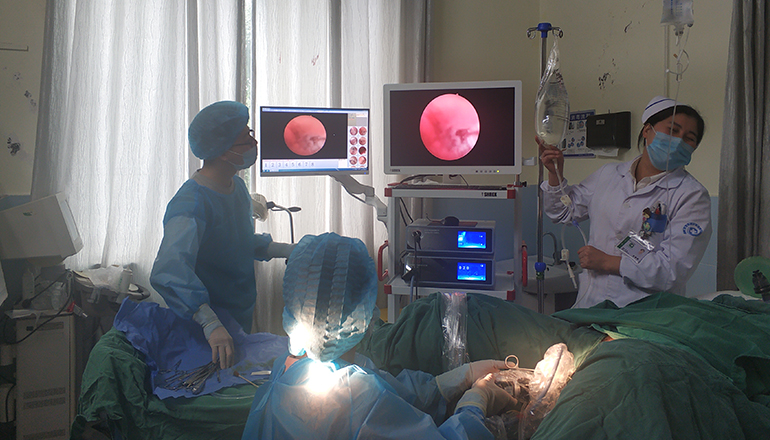- Shanghai, China
- [email protected]
- +86-21-58189111
Hysteroscopic endometrial polypectomy is a minimally invasive surgical procedure used to remove endometrial polyps, which are growths that develop on the inner lining of the uterus. Endometrial polyps can cause abnormal uterine bleeding, pelvic pain, and infertility, among other symptoms.
During a hysteroscopic endometrial polypectomy, a hysteroscope (a thin, flexible instrument with a camera and light source) is inserted through the cervix and into the uterus. The surgeon uses specialized instruments to remove the polyps, which are then sent to a lab for further analysis.
The procedure is usually performed under local or general anesthesia, and patients can usually go home the same day. After the procedure, patients may experience mild cramping and vaginal bleeding, which usually resolves within a few days.
Hysteroscopic endometrial polypectomy is a safe and effective procedure for the treatment of endometrial polyps. The procedure has several advantages over traditional open surgery, including less pain, a faster recovery time, and a lower risk of complications. In addition, the procedure does not require any incisions, which means there is little to no scarring.
However, not all endometrial polyps are suitable for hysteroscopic endometrial polypectomy. The size, location, and number of polyps will determine whether the procedure is appropriate. Patients with large or multiple polyps may require more extensive treatment, such as a hysterectomy.

It is important for patients to discuss their treatment options with their healthcare provider and weigh the benefits and risks of each option before making a decision. Factors like the size and location of the polyps, as well as the patient's age and desire for future fertility, will all play a role in determining the most appropriate treatment plan.
In addition to hysteroscopic endometrial polypectomy, there are several other treatment options for endometrial polyps, including medication and traditional surgery. Patients should consult with a qualified gynecologist or reproductive specialist to determine if this procedure is appropriate for their individual needs and circumstances.
Hysteroscopic endometrial polypectomy is a minimally invasive and effective procedure for the treatment of endometrial polyps. The procedure offers many benefits over traditional surgery and has a high success rate when performed by a skilled and experienced surgeon. Patients should work closely with their healthcare provider to determine if this procedure is appropriate for their individual needs and circumstances, and to explore other treatment options if necessary.
It is important for patients to follow post-operative instructions and attend follow-up appointments to monitor their recovery and ensure the successful removal of the polyps. Patients may also require additional testing, such as ultrasound or hysteroscopy, to confirm the complete removal of the polyps and to monitor for recurrence.
Patients should also be aware of the potential risks and complications associated with hysteroscopic endometrial polypectomy, such as bleeding, infection, perforation of the uterus, and complications related to anesthesia. However, these risks are generally low and can be minimized by choosing a qualified and experienced surgeon and following pre- and post-operative instructions carefully.
In conclusion, hysteroscopic endometrial polypectomy is a safe and effective procedure for the treatment of endometrial polyps. The procedure offers many benefits over traditional surgery and has a high success rate when performed by a skilled and experienced surgeon. Patients should work closely with their healthcare provider to determine if this procedure is appropriate for their individual needs and circumstances, and to explore other treatment options if necessary.
Leave a Comments